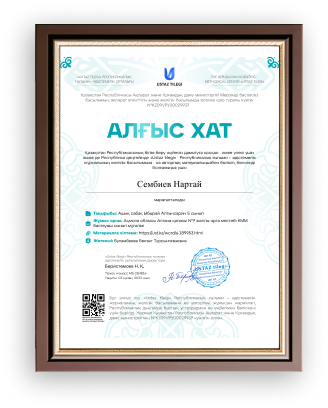
Checked----------------------------------
|
Module 5 My free time! |
School named after T.Shonanuly |
|||||||
|
Date: |
Teacher name: |
|||||||
|
Grade: 3 |
Number present: |
absent: |
||||||
|
Lesson theme |
I like playing/ I don’t like doing. |
|||||||
|
Learning objectives |
3.1.4.1 understand basic personal questions; 3.2.2.1 use isolated words and basic expressions to provide personal information; 3.2.3.1 respond to basic questions with single words or short responses; 3.3.3.1 follow short, simple instructions used in familiar everyday contexts; 3.3.3.2 find out the main points in short simple descriptions with visual support; 3.5.1.10 use common present simple forms and contractions on a limited range of familiar topics; 3.5.1.16 use let’s + verb, verbs go/like + verb + ing. |
|||||||
|
Lesson objectives |
Learners will be able to:
|
|||||||
|
Plan |
||||||||
|
|
Stages / Time |
Teachers actions |
Students’ actions |
Assessment criteria |
Resources |
|||
|
|
Beginning of the lesson Warming-up 7 min |
Organization moment: Greeting Make a puzzle : can\can’t +picture |
The pupils work in pairs |
The teacher assess learners for their ability. “Good job! Well done!” |
Pictures worksheet |
|||
|
|
Middle of the lesson Presentationand practice. 30 min |
Present like + verb + ing. Books closed. Say as you write on the board: Do you like cooking? Yes, I do./No, I don’t. Underline the words in bold. The pupils repeat after you. Explain how we form the interrogative and the short answers. Remind the pupils that the verb like is followed by the -ing form. Explain that most verbs do not change when we add -ing (painting, climbing, cooking) but there are exceptions to that rule. Present the spelling difficulties. Say, then write on the board: have – having. Explain that the verbs that end in -e, drop the -e before they take the -ing ending. Follow the same procedure and present run – running. Game: Find a pair of gloves Books open. Go through the Grammar box briefly. Read the instructions and explain the activity. Allow the pupils some time to complete the sentences. Then they match the sentences to the corresponding pictures. Check their answers. |
Do you like painting? Yes, I do. No, I don’t. paint – painting BUT swim – swimming ride – riding The students will find a pair of gloves and аnd say activities with +ing The pupils match the sentences to the corresponding pictures |
Observing and monitiring |
P.B.p.63, ex.2 Worksheet IWB |
|||
|
|
To present and practice grammar and punctuation mistakes. Say as you write on the board: My name’s Aizhan. Underline the letters in bold. Explain that we use capital letters for the first word of a sentence and that we also use capital letters for names. Write on the board and say: I like run and jumping? Point to and explain the mistakes. The verb like is always followed by the -ing form and we use the question mark only in questions. In affirmative sentences we use a full stop. Allow the pupils some time to find the mistakes and correct them. Check their answers |
The pupils read and correct sentences. |
Teacher’s assessment |
P.B.p.63, ex.3 IWB |
||||
|
|
Practice talking about preferences. Point to the picture. Read the exchange and explain the activity. In pairs, the pupils practice talking about what they like doing. One pupil mimes the activity and the other pupil tries to guess. Go around the classroom providing any necessary help. Ask some pairs to come to the front of the classroom and act out their dialogues |
Act out the dialogues |
|
Exercise 3 Worksheet |
||||
|
|
End of the lesson 8 min |
Consolidate the language of the lesson. Play game aquarium There are some words in the aquarium that students must find and write a sentence with an expression I like V+ing\ I don’t like V+ing |
Feedback: Flowers |
Poster Success
|
||||
|
|
|
Dance “I like…..” Assessment sheet |
Leaners assess yourself |
|
||||
|
|
|
|
|
||
|
I can talk about can /can’t activities |
|
|
|
||
|
I can say what I like doing |
|
|
|
||
|
I can say what I don’t like doing |
|
|
|
||
|
I can write what I like\ I don’t like doing |
|
|
|
||
жүктеу мүмкіндігіне ие боласыз
Бұл материал сайт қолданушысы жариялаған. Материалдың ішінде жазылған барлық ақпаратқа жауапкершілікті жариялаған қолданушы жауап береді. Ұстаз тілегі тек ақпаратты таратуға қолдау көрсетеді. Егер материал сіздің авторлық құқығыңызды бұзған болса немесе басқа да себептермен сайттан өшіру керек деп ойласаңыз осында жазыңыз
I like playing/ I don’t like doing.
I like playing/ I don’t like doing.
Checked----------------------------------
|
Module 5 My free time! |
School named after T.Shonanuly |
|||||||
|
Date: |
Teacher name: |
|||||||
|
Grade: 3 |
Number present: |
absent: |
||||||
|
Lesson theme |
I like playing/ I don’t like doing. |
|||||||
|
Learning objectives |
3.1.4.1 understand basic personal questions; 3.2.2.1 use isolated words and basic expressions to provide personal information; 3.2.3.1 respond to basic questions with single words or short responses; 3.3.3.1 follow short, simple instructions used in familiar everyday contexts; 3.3.3.2 find out the main points in short simple descriptions with visual support; 3.5.1.10 use common present simple forms and contractions on a limited range of familiar topics; 3.5.1.16 use let’s + verb, verbs go/like + verb + ing. |
|||||||
|
Lesson objectives |
Learners will be able to:
|
|||||||
|
Plan |
||||||||
|
|
Stages / Time |
Teachers actions |
Students’ actions |
Assessment criteria |
Resources |
|||
|
|
Beginning of the lesson Warming-up 7 min |
Organization moment: Greeting Make a puzzle : can\can’t +picture |
The pupils work in pairs |
The teacher assess learners for their ability. “Good job! Well done!” |
Pictures worksheet |
|||
|
|
Middle of the lesson Presentationand practice. 30 min |
Present like + verb + ing. Books closed. Say as you write on the board: Do you like cooking? Yes, I do./No, I don’t. Underline the words in bold. The pupils repeat after you. Explain how we form the interrogative and the short answers. Remind the pupils that the verb like is followed by the -ing form. Explain that most verbs do not change when we add -ing (painting, climbing, cooking) but there are exceptions to that rule. Present the spelling difficulties. Say, then write on the board: have – having. Explain that the verbs that end in -e, drop the -e before they take the -ing ending. Follow the same procedure and present run – running. Game: Find a pair of gloves Books open. Go through the Grammar box briefly. Read the instructions and explain the activity. Allow the pupils some time to complete the sentences. Then they match the sentences to the corresponding pictures. Check their answers. |
Do you like painting? Yes, I do. No, I don’t. paint – painting BUT swim – swimming ride – riding The students will find a pair of gloves and аnd say activities with +ing The pupils match the sentences to the corresponding pictures |
Observing and monitiring |
P.B.p.63, ex.2 Worksheet IWB |
|||
|
|
To present and practice grammar and punctuation mistakes. Say as you write on the board: My name’s Aizhan. Underline the letters in bold. Explain that we use capital letters for the first word of a sentence and that we also use capital letters for names. Write on the board and say: I like run and jumping? Point to and explain the mistakes. The verb like is always followed by the -ing form and we use the question mark only in questions. In affirmative sentences we use a full stop. Allow the pupils some time to find the mistakes and correct them. Check their answers |
The pupils read and correct sentences. |
Teacher’s assessment |
P.B.p.63, ex.3 IWB |
||||
|
|
Practice talking about preferences. Point to the picture. Read the exchange and explain the activity. In pairs, the pupils practice talking about what they like doing. One pupil mimes the activity and the other pupil tries to guess. Go around the classroom providing any necessary help. Ask some pairs to come to the front of the classroom and act out their dialogues |
Act out the dialogues |
|
Exercise 3 Worksheet |
||||
|
|
End of the lesson 8 min |
Consolidate the language of the lesson. Play game aquarium There are some words in the aquarium that students must find and write a sentence with an expression I like V+ing\ I don’t like V+ing |
Feedback: Flowers |
Poster Success
|
||||
|
|
|
Dance “I like…..” Assessment sheet |
Leaners assess yourself |
|
||||
|
|
|
|
|
||
|
I can talk about can /can’t activities |
|
|
|
||
|
I can say what I like doing |
|
|
|
||
|
I can say what I don’t like doing |
|
|
|
||
|
I can write what I like\ I don’t like doing |
|
|
|
||

шағым қалдыра аласыз
















